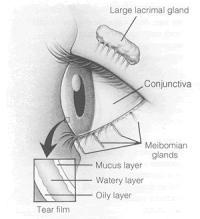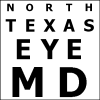Dry Eye Syndrome
Dry Eye Syndrome is a very common condition caused by either decreased tear production or increased tear evaporation. The tear film has multiple layers and is produced by numerous different glands located in the tissues around the eye. If one or all of these components is produced in decreased levels, tears tend to evaporate faster than normal, leaving the eye in a relatively tear-deficient state.
Symptoms of dry eye include: 
- Foreign Body Sensation
- Burning
- Eye and eyelid soreness
- Blurry vision
- Tearing
The tear film both lubricates the cornea and conjuctiva and provides a smooth even surface through which light can be focused into the eye. The absence of an adequate tear film can lead to slight blurring of vision, as well as a gritty sensation as the cornea rubs against the inside of the eyelid during blinking. As the corneal surface dries out, reflex tearing occurs to protect the corneal surface from breaking down. This is why tearing can be associated with dry eyes.
Low-grade inflammation often accompanies dryness, which in turn leads to an additional decrease in tear production. Medications to combat inflammation are sometimes required in the treatment of dry eye.
Environment can often play a significant role, especially in dry climates. Activities like reading and computer use can also aggravate dry eyes due to the fact that blinking is often reduced during these activities. Some systemic diseases (i.e. Rheumatoid arthritis, Sjögren’s Syndrome) can also cause dry eyes. A complete eye exam by an ophthalmologist is recommended.
Treatment of dry eye can include:
- Replacement of artificial tears. Many brands of artificial tears are available over-the-counter (Refresh, Systane, Genteal, Theratears, etc.) including many generics. Initially, tears should be done 4-5 times a day and can be tapered to meet your eye’s needs. In some cases, tears may be required more frequently. If you require tears more frequently than 5 times a day, you may need to switch to preservative-free artificial tears, as the preservatives in eyedrops can irritate the eye if used too frequently. >
-
Medications to fight inflammation. Restasis twice a day is an effective and safe long-term treatment for dry eyes. It is a mild immune modulator that blocks the inflammatory pathway that leads to decreased tear production. However, daily use for 2-3 months is needed before the full effect of the medication is realized. Topical steroids are also used for short-term treatment of dry eyes, but are not recommended for long-term use due to potential side effects (cataracts, glaucoma) that can occur. -
Punctal occlusion. There are openings on both the upper and lower eyelid through which tears drain away from the eye and into the nose. Small silicone plugs can be placed into the lower openings to prevent premature drainage of the tears. These can be placed in the office during your visit. Over time, the punctal plugs may fall out; however, due to their small size and location, most patients are unaware of their presence. Permanent punctal occlusion may also be done in severe cases.
